Box ovens cook better outdoors because they're specifically designed to harness and maintain heat efficiently in open-air environments. You'll get ideal results from multiple insulation layers like crumpled newspapers and fiberglass, while the foil-lined interior reflects heat back to your food. The double-walled construction creates an effective barrier against heat loss, and proper ventilation guarantees consistent airflow. Your dark-colored cookware will absorb heat better, and positioning the oven correctly relative to sunlight maximizes energy efficiency. Weather conditions play a vital role too – understanding how to adapt to different outdoor factors will transform your box oven cooking experience.
Heat Distribution and Insulation Methods
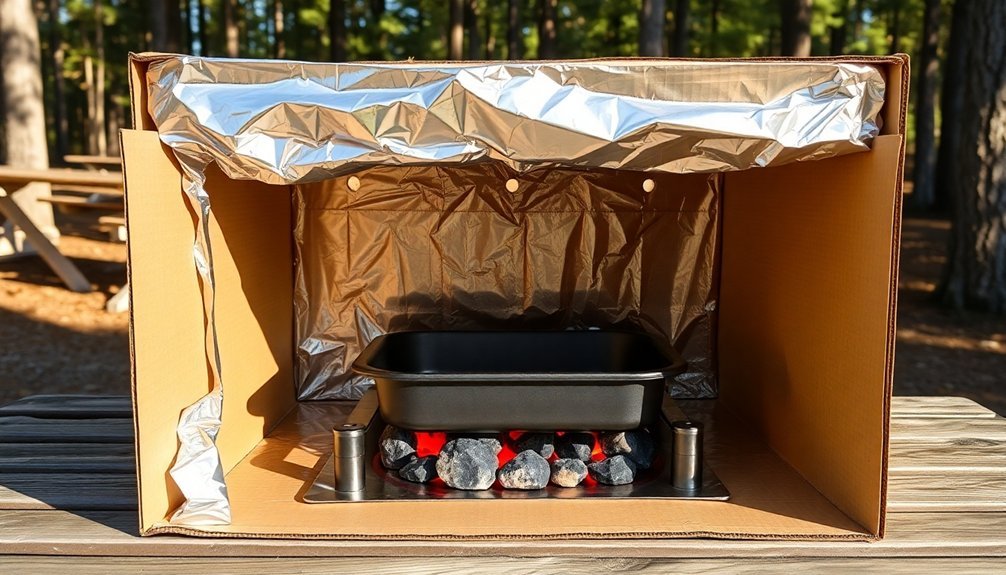
When building a box oven for outdoor cooking, proper heat distribution and insulation methods play essential roles in achieving consistent cooking temperatures.
You'll need to incorporate multiple insulation layers, such as crumpled newspapers or fiberglass, while guaranteeing you don't compress them to maintain their effectiveness. Create an air space above your insulation to act as a decompression chamber. Cover the insulation area with black construction paper to maximize heat absorption.
For ideal heat distribution, adjust your reflective flap angles to direct sunlight efficiently into the cooking area. You'll want to install support structures to guarantee even heat circulation around your cookware.
Monitor temperatures with a thermometer and maintain a gap at the bottom of your oven to allow hot air to rise naturally. Choose materials with high R-values and use vermiculite concrete bonded with refractory cement for enhanced thermal performance.
Building Your Perfect Box Oven
| Component | Purpose |
|---|---|
| Foil Lining | Heat reflection |
| Double Walls | Insulation barrier |
| Wire Rack | Food platform |
| Ventilation Holes | Airflow control |
Start by cutting your door and securing it with foil tape. Line every interior surface with aluminum foil, ensuring complete coverage. Create double walls for superior insulation, and install your wire rack using a modified coat hanger. Don't forget to add strategic ventilation holes for proper airflow. Position the aluminum tray at the bottom, add sand or rocks for insulation, and you're ready to start cooking. Once assembled, add ten charcoal briquettes to achieve a cooking temperature of approximately 400 degrees Fahrenheit.
Proper Temperature Control Techniques
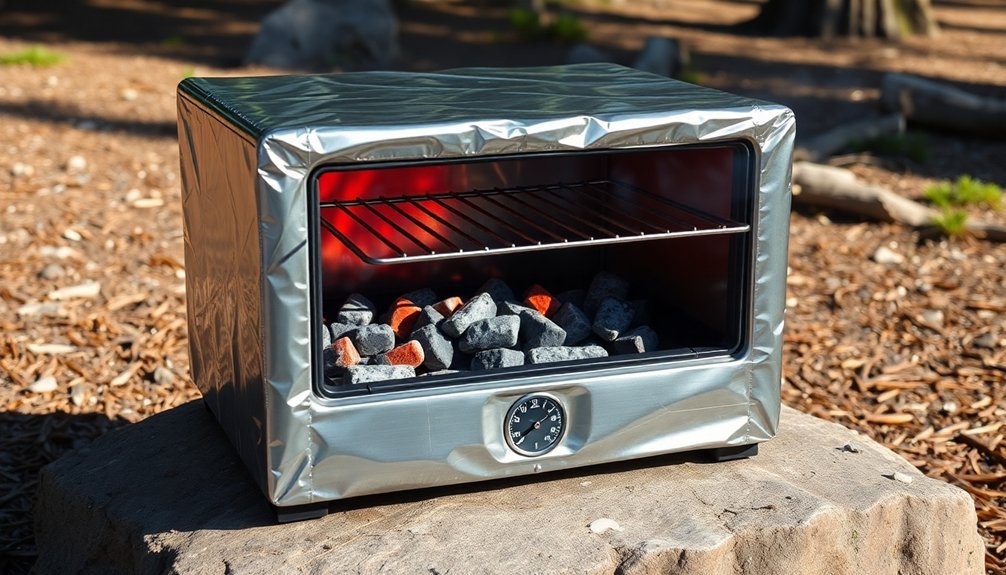
Three key principles govern successful box oven cooking: accurate temperature monitoring, heat retention, and environmental adaptation.
You'll need to manage your heat source carefully – whether it's charcoal (where 12 briquettes yield about 350 degrees) or solar energy (which can reach up to 266°F). Proper heavy-duty aluminum foil lining inside the box reflects heat efficiently for optimal cooking temperatures.
Keep your oven sealed and well-insulated to maintain ideal cooking temperatures.
- Monitor temperature with an oven thermometer, and use dark-colored cookware that absorbs heat better.
- Minimize opening the oven door, as each peek can drop temperature by 50-100 degrees.
- Adjust for weather conditions – double cooking time on cloudy days if using solar power.
- Track the sun every 20 minutes when using a solar box oven, and keep reflectors clean for maximum efficiency.
Essential Safety Protocols
Safe operation of a box oven requires careful attention to several critical protocols before, during, and after cooking. You'll need to position your box oven in a well-ventilated area away from flammable materials and guarantee it's on a stable, heat-resistant surface. Remember to wear closed-toe shoes to protect your feet from any potential hot debris that may fall.
| Safety Area | What to Do | What to Avoid |
|---|---|---|
| Setup | Use heat-resistant surface | Placing near structures |
| Operation | Monitor temperature | Leaving unattended |
| Tools | Use long-handled equipment | Bare-handed handling |
| Emergency | Keep extinguisher ready | Using water on fires |
Always wear heat-resistant gloves when handling hot items, and keep a fire extinguisher nearby. If a fire occurs, don't use water; instead, close the oven door and turn off the heat source. Maintain your oven by cleaning it regularly and checking for wear and tear to guarantee safe, continued operation.
Outdoor Cooking Success Factors
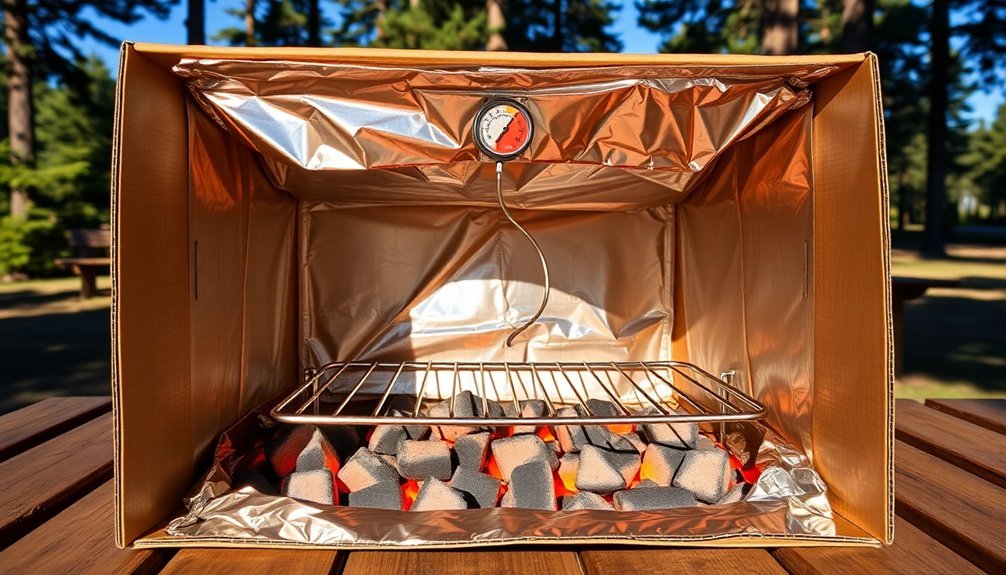
Achieving success with outdoor box oven cooking depends on four key factors: heat management, proper insulation, strategic location, and thorough preparation.
You'll need to master these elements to create delicious meals in your box oven.
- Control your heat source by using charcoal briquettes efficiently – each one generates about 40 degrees of heat. Preheat for 5 minutes to maintain temperature for an hour.
- Create proper insulation by lining your box with aluminum foil and securing it with duct tape. Add newspaper layers to prevent heat escape.
- Choose a location at least 10 feet from flammable materials, away from wind, and on a stable, heat-resistant surface.
- Plan ahead by preparing ingredients at home and bringing all necessary cooking gear.
Remember that outdoor cooking often takes longer than indoor cooking.
Box Oven Recipe Adaptations
When cooking with a box oven, you'll need to adjust standard recipes by closely monitoring temperatures and extending cooking times by 10-15 minutes to compensate for heat fluctuations.
You can maintain proper moisture levels by using a water pan or aluminum foil covering, especially for dishes that tend to dry out quickly in outdoor conditions.
Keep your portions modest, using smaller baking dishes that fit comfortably within the box oven's dimensions while allowing proper air circulation around the food.
Temperature Timing Adjustments
Successfully adapting traditional recipes for box oven cooking requires careful temperature and timing adjustments. You'll need to monitor your briquettes closely, as each one generates about 40 degrees of heat.
When adjusting cooking times, remember that higher temperatures reduce cooking duration – for instance, cooking at 450°F instead of 400°F cuts your cooking time by 11%.
- Always use an oven thermometer to verify the actual temperature inside your box oven.
- Calculate new cooking times by multiplying the original time by the temperature ratio (e.g., 400°F/450°F = 89%).
- Check your food earlier than the calculated time to prevent overcooking.
- Start with recipes that are more forgiving regarding temperature precision, like savory dishes, before attempting temperature-sensitive baked goods.
For consistent results, maintain proper ventilation and confirm your briquettes are fully preheated before placing them in the oven.
Moisture Control Methods
Proper moisture control in box oven cooking determines whether your dishes turn out perfectly done or disappointingly soggy.
You'll need to start by lining your cardboard box with multiple layers of aluminum foil, which reflects heat while preventing moisture from escaping or seeping in.
To regulate humidity, you'll want to position the lid with a slight gap for controlled airflow.
Place a wire rack on aluminum cans to elevate your food, allowing better air circulation.
Adding sand or pinto beans in pans beneath helps absorb excess moisture and distributes heat evenly.
Don't forget to preheat your oven for a few minutes to stabilize the internal environment.
For best results, use your box oven outdoors where natural ventilation helps manage moisture levels.
The combination of proper airflow and heat reflection will keep your food cooking evenly.
Portion Size Guidelines
Adapting recipes for box oven cooking requires careful attention to portion sizes and ingredient scaling. You'll need to adjust traditional recipes to work effectively in your outdoor box oven setup. When scaling down recipes, use 1 cup of mix for every 6 muffins and maintain proper ingredient ratios to guarantee successful results.
- Scale your recipes down to 6 servings or fewer to prevent overcrowding and guarantee even cooking.
- Reduce dry ingredient quantities proportionally, keeping the original recipe ratios intact.
- Add mix-ins like nuts or berries in moderation to maintain proper baking consistency.
- Allow for longer cooking times, typically 50% more than conventional ovens.
Remember to use smaller containers that fit comfortably in your box oven, and always check for doneness since cooking times may vary based on outdoor conditions.
Weather Impact on Performance
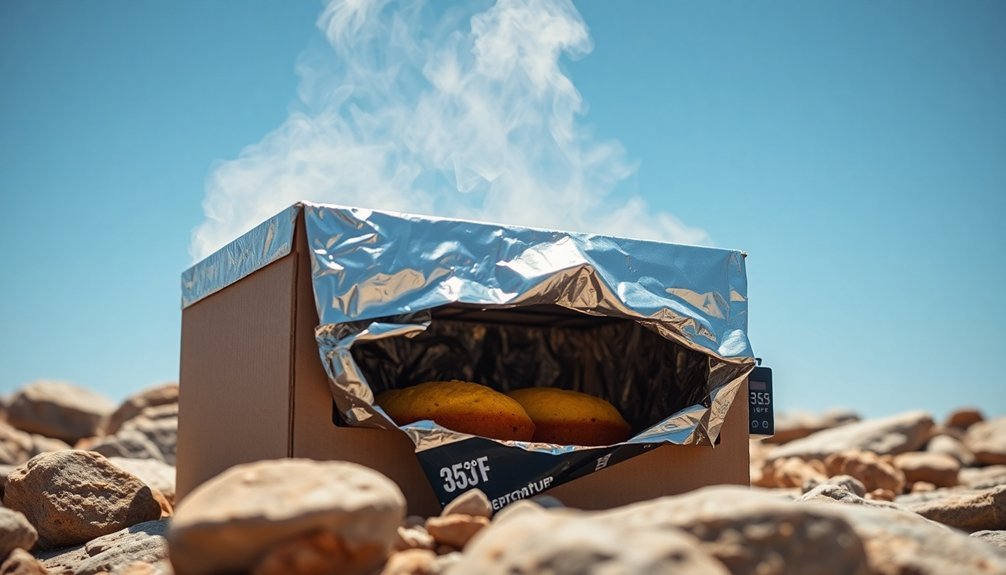
While outdoor cooking with box ovens offers versatility, weather conditions greatly influence their performance and cooking results.
You'll need to adapt your cooking approach based on temperature fluctuations, humidity levels, and altitude.
In hot weather, your box oven will heat faster and maintain temperature more easily. However, cold conditions, rain, or wind will make it harder to achieve and maintain ideal cooking heat.
You'll notice humidity affects cooking times too – high humidity speeds up cooking as moisture stays on food surfaces, while low humidity slows it down.
If you're cooking at higher altitudes, you'll need to adjust for lower atmospheric pressure.
Water boils at lower temperatures up high, so you'll want to cook longer at reduced temperatures to compensate for faster moisture evaporation.
Frequently Asked Questions
Can I Use My Box Oven During Light Rain?
You shouldn't use your box oven during light rain. It'll considerably reduce cooking efficiency since rain blocks sunlight, weakens the greenhouse effect, and compromises heat retention. Consider using alternative cooking methods during wet weather.
How Many Times Can I Reuse the Same Cardboard Box Oven?
You can typically reuse your cardboard box oven 3-5 times safely before it starts degrading. Keep an eye on its condition – once you notice warping, weakened spots, or burnt areas, it's time to replace it.
Will Different Types of Charcoal Affect Cooking Performance?
Yes, your charcoal choice greatly affects cooking performance. You'll get hotter, faster cooking with lump charcoal, while briquettes burn longer and steadier. Natural hardwood charcoal provides better flavor for your food.
Can Aluminum Cans Be Replaced With Other Household Items?
You can replace aluminum cans with sustainable alternatives like beeswax wraps, stainless steel containers, ceramic pans, and silicone food bags. These eco-friendly options offer better safety and reusability for your cooking needs.
Does Elevation Affect Cooking Times in a Box Oven?
Yes, elevation will affect your box oven's cooking times. You'll need longer cooking times at higher elevations since water boils at lower temperatures. Consider adding 15-25% more time to your recipes.
In Summary
You'll find box ovens deliver superior outdoor cooking results through their efficient heat distribution and insulation. By properly maintaining temperature control and following safety protocols, you're able to create delicious meals in any weather. With the right construction techniques and recipe adaptations, your box oven becomes a reliable outdoor cooking companion that's both versatile and effective. Keep practicing, and you'll master this time-tested cooking method.

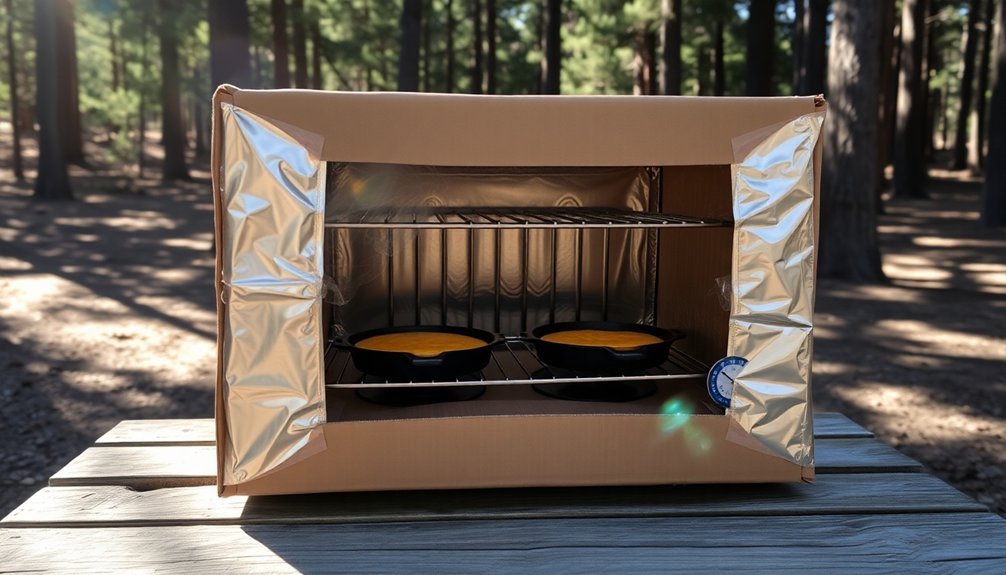



Leave a Reply